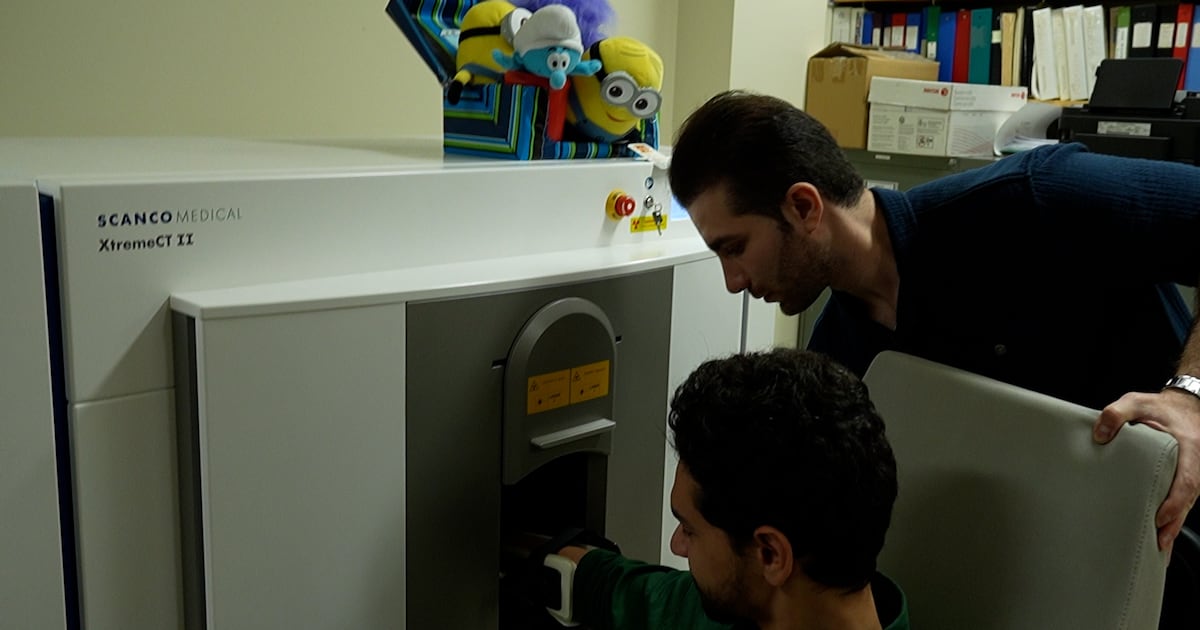Science
Researchers at University of Saskatchewan Study Bone Strength in Children

A team of researchers at the University of Saskatchewan is pioneering a groundbreaking study focused on understanding children’s bone strength using an advanced imaging device. This initiative, part of the Canadian Bone Strength Development Study, aims to investigate why some children, particularly those with Type 1 diabetes, exhibit increased fragility in their bones compared to their peers.
The university recently acquired a second-generation high-resolution peripheral quantitative computed tomography (HR-pQCT) scanner, funded by the Canada Foundation for Innovation. This state-of-the-art equipment allows researchers to take detailed images of bone structures, which are crucial for assessing bone strength.
Ali Rezaei, a PhD candidate in the College of Kinesiology, is responsible for operating the scanner during sessions with young participants. “They’re always curious about the machine at first,” Rezaei explained. “Once I explain how it works, they relax, and all they have to do is sit still for about two minutes.” This short scanning process captures intricate images that engineers can then analyze to create digital models of bone strength.
Understanding Bone Development
The research team, including Saija Kontulainen, associate dean of research in the College of Kinesiology, J.D. Johnston from the College of Engineering, and Dr. Munier Nour from the College of Medicine, seeks to unravel the complexities of bone growth. Kontulainen noted, “When we know how bones are growing, we can design interventions to help optimize that.”
Children with Type 1 diabetes are known to be at a higher risk for fractures, but the specific reasons behind this vulnerability remain unclear. By participating in this study, researchers hope to gather significant data that could lead to earlier interventions aimed at improving bone strength and enhancing the long-term quality of life for affected children.
The study is currently in the recruitment phase, searching specifically for participants aged 10 to 11 years for girls and 11 to 12 years for boys. This research represents a significant step towards understanding bone health in children and developing effective strategies for prevention and treatment. With ongoing advancements in imaging technology, the hope is that findings from this study will contribute to vital breakthroughs in pediatric health.
-

 Education3 months ago
Education3 months agoBrandon University’s Failed $5 Million Project Sparks Oversight Review
-

 Science4 months ago
Science4 months agoMicrosoft Confirms U.S. Law Overrules Canadian Data Sovereignty
-

 Lifestyle3 months ago
Lifestyle3 months agoWinnipeg Celebrates Culinary Creativity During Le Burger Week 2025
-

 Health4 months ago
Health4 months agoMontreal’s Groupe Marcelle Leads Canadian Cosmetic Industry Growth
-

 Technology3 months ago
Technology3 months agoDragon Ball: Sparking! Zero Launching on Switch and Switch 2 This November
-

 Science4 months ago
Science4 months agoTech Innovator Amandipp Singh Transforms Hiring for Disabled
-

 Education3 months ago
Education3 months agoRed River College Launches New Programs to Address Industry Needs
-

 Technology4 months ago
Technology4 months agoGoogle Pixel 10 Pro Fold Specs Unveiled Ahead of Launch
-

 Business3 months ago
Business3 months agoRocket Lab Reports Strong Q2 2025 Revenue Growth and Future Plans
-

 Technology2 months ago
Technology2 months agoDiscord Faces Serious Security Breach Affecting Millions
-

 Education3 months ago
Education3 months agoAlberta Teachers’ Strike: Potential Impacts on Students and Families
-

 Science3 months ago
Science3 months agoChina’s Wukong Spacesuit Sets New Standard for AI in Space
-

 Education3 months ago
Education3 months agoNew SĆIȺNEW̱ SṮEȽIṮḴEȽ Elementary Opens in Langford for 2025/2026 Year
-

 Technology4 months ago
Technology4 months agoWorld of Warcraft Players Buzz Over 19-Quest Bee Challenge
-

 Business4 months ago
Business4 months agoNew Estimates Reveal ChatGPT-5 Energy Use Could Soar
-

 Business3 months ago
Business3 months agoDawson City Residents Rally Around Buy Canadian Movement
-

 Technology2 months ago
Technology2 months agoHuawei MatePad 12X Redefines Tablet Experience for Professionals
-

 Business3 months ago
Business3 months agoBNA Brewing to Open New Bowling Alley in Downtown Penticton
-

 Technology4 months ago
Technology4 months agoFuture Entertainment Launches DDoD with Gameplay Trailer Showcase
-

 Technology4 months ago
Technology4 months agoGlobal Launch of Ragnarok M: Classic Set for September 3, 2025
-

 Technology4 months ago
Technology4 months agoInnovative 140W GaN Travel Adapter Combines Power and Convenience
-

 Science4 months ago
Science4 months agoXi Labs Innovates with New AI Operating System Set for 2025 Launch
-

 Top Stories2 months ago
Top Stories2 months agoBlue Jays Shift José Berríos to Bullpen Ahead of Playoffs
-

 Technology4 months ago
Technology4 months agoNew IDR01 Smart Ring Offers Advanced Sports Tracking for $169










